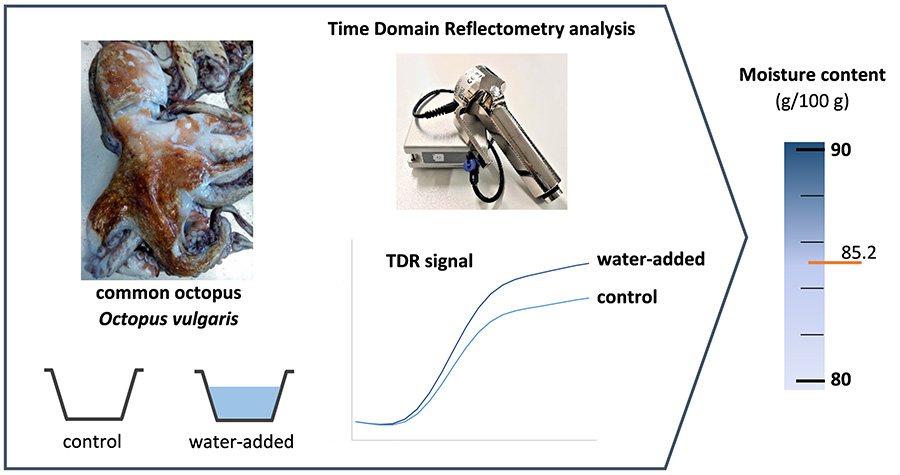SEATRACES PUBLICATION
Bárbara Teixeira, Helena Vieira, Sandra Martins and Rogério Mendes
Bárbara Teixeira, Helena Vieira, Sandra Martins and Rogério Mendes, IPMA researchers, recently published a paper in Foods on the Quantitation of Water Addition in Octopus Using Time Domain Reflectometry. This study aimed to develop a rapid and non-destructive method to control abusive water addition to octopus based on time-domain reflectometry analysis (TDR). To detect and quantify the water content in the octopus muscle, their samples were immersed in freshwater for different periods (0.5–32 h) to give a wide range of moisture contents representing different commercial conditions. Control and water-added octopus were analyzed with a TDR sensor, and data correlated with moisture content were used for calibration and method validation. A maximum limit of moisture content of 85.2 g/100 g in octopus is proposed for conformity assessment unless the label indicates that water (>5%) was added. The TDR methodology was calibrated with the purpose of detection and quantitation of water in O. vulgaris, thus showing that a rapid and non-destructive methodology based on changes in the dielectric properties of the muscle can be used for such an aim. Thus, microwave dielectric spectroscopy using TDR analysis can discriminate between control and water-added octopus, especially for octopus immersed in freshwater for more extended periods (32 h). In addition, moisture content can be quantified in O. vulgaris with TDR analysis, in the range of 80–90 g/100 g, with an RMSE of 1.1%. Each analysis with the TDR technology has been performed within a few seconds, and it does not perforate or cause any other damage to octopus. TDR data and correlation with moisture content show that this non-destructive methodology can be used by the industry and quality control inspections for assessment of octopus quality and to verify compliance with legislation, promote fair trade practices, and further contribute to sustainable use resources.

Abstract:
A rapid and non-destructive method based in time domain reflectometry analysis (TDR), which detects and quantifies the water content in the muscle, was developed for the control of abusive water addition to octopus. Common octopus samples were immersed in freshwater for different periods (0.5–32 h) to give a wide range of moisture contents, representing different commercial conditions. Control and water-added octopus were analyzed with a TDR sensor, and data correlated with moisture content were used for calibration and method validation. A maximum limit of moisture content of 85.2 g/100 g in octopus is proposed for conformity assessment, unless the label indicates that water (>5%) was added. Calibration results showed that TDR analysis can discriminate control and water-added octopus, especially for octopus immersed for longer periods (32 h). In addition, moisture content can be quantified in octopus using only TDR analysis (between 80 and 90 g/100 g; RMSE = 1.1%). TDR data and correlation with moisture content show that this non-destructive methodology can be used by the industry and quality control inspections for assessment of octopus quality and to verify compliance with legislation, promoting fair trade practices, and further contributing to a sustainable use of resources.
Journal: Foods